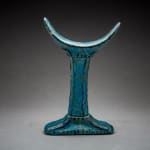Egyptian Faience Headrest
faience
19.1 x 12.1 cm
7 1/2 x 4 3/4 in
7 1/2 x 4 3/4 in
LO.1173
Further images
This headdress in a deep blue faience with black glaze details was crafted as three individual pieces—the base, the shaft, and the headrest proper—which were designed to fit seamlessly into...
This headdress in a deep blue faience with black glaze details was crafted as three individual pieces—the base, the shaft, and the headrest proper—which were designed to fit seamlessly into one another.
Although used in life, as the furniture from the tomb of Queen Hetepheres found at Giza suggests, headrests were also included among the funerary furnishings provided for the deceased in order to insure that one’s head did not become separated from one’s body in the Hereafter. This religious conceit is clearly articulated in Spell 166 of the so-called Book of the Dead in which one reads, “Your head shall not be taken from you afterwards/your head shall not be taken from you for ever.”
The dating of our headdress may be suggested by considering the nature of its faience and its shape. In general, headdress of the earlier periods of ancient Egyptian history are characterized by a single, relatively tall shaft whereas in the later periods, beginning with Dynasty XVIII, the shafts appear to become somewhat more squat and thicker and these are set into relatively larger bases which rise up in wide sweeping tapers toward the intersection with the shaft. If one adheres to this suggested development of the type, our headrest shares more in common with earlier than later examples. The color of the faience used would tend to support a dating within the Middle Kingdom, and this suggested dating is in keeping with the development just outlined. As such our headdress is an early, and rarely encountered, example of the type in faience.
References:
See, W. M. Flinders Petrie, Objects of Daily Use (London1927), plates XXX-XXXII for the various types of headdresses; A. Weise and A. Brodbeck, Tutankhamun. The Golden Beyond. Tomb Treasures from the Valley of the Kings (Basel 2004), pages 314-315, for a discussion of the religious symbolism of the headrest; W. Stevenson Smith, Ancient Egypt as Represented in the Museum of Fine Arts, Boston (Boston 1960), pages 68-69, for the furniture from the tomb of Queen Hetepheres.
Description and interpretation kindly provided by Prof. Robert S. Bianchi.
Although used in life, as the furniture from the tomb of Queen Hetepheres found at Giza suggests, headrests were also included among the funerary furnishings provided for the deceased in order to insure that one’s head did not become separated from one’s body in the Hereafter. This religious conceit is clearly articulated in Spell 166 of the so-called Book of the Dead in which one reads, “Your head shall not be taken from you afterwards/your head shall not be taken from you for ever.”
The dating of our headdress may be suggested by considering the nature of its faience and its shape. In general, headdress of the earlier periods of ancient Egyptian history are characterized by a single, relatively tall shaft whereas in the later periods, beginning with Dynasty XVIII, the shafts appear to become somewhat more squat and thicker and these are set into relatively larger bases which rise up in wide sweeping tapers toward the intersection with the shaft. If one adheres to this suggested development of the type, our headrest shares more in common with earlier than later examples. The color of the faience used would tend to support a dating within the Middle Kingdom, and this suggested dating is in keeping with the development just outlined. As such our headdress is an early, and rarely encountered, example of the type in faience.
References:
See, W. M. Flinders Petrie, Objects of Daily Use (London1927), plates XXX-XXXII for the various types of headdresses; A. Weise and A. Brodbeck, Tutankhamun. The Golden Beyond. Tomb Treasures from the Valley of the Kings (Basel 2004), pages 314-315, for a discussion of the religious symbolism of the headrest; W. Stevenson Smith, Ancient Egypt as Represented in the Museum of Fine Arts, Boston (Boston 1960), pages 68-69, for the furniture from the tomb of Queen Hetepheres.
Description and interpretation kindly provided by Prof. Robert S. Bianchi.





